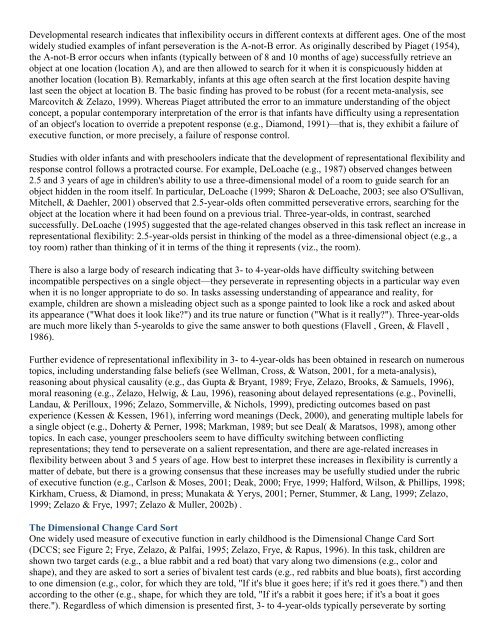THE DEVELOPMENT OF EXECUTIVE FUNCTION IN EARLY ...
THE DEVELOPMENT OF EXECUTIVE FUNCTION IN EARLY ...
THE DEVELOPMENT OF EXECUTIVE FUNCTION IN EARLY ...
Create successful ePaper yourself
Turn your PDF publications into a flip-book with our unique Google optimized e-Paper software.
Developmental research indicates that inflexibility occurs in different contexts at different ages. One of the most<br />
widely studied examples of infant perseveration is the A-not-B error. As originally described by Piaget (1954),<br />
the A-not-B error occurs when infants (typically between of 8 and 10 months of age) successfully retrieve an<br />
object at one location (location A), and are then allowed to search for it when it is conspicuously hidden at<br />
another location (location B). Remarkably, infants at this age often search at the first location despite having<br />
last seen the object at location B. The basic finding has proved to be robust (for a recent meta-analysis, see<br />
Marcovitch & Zelazo, 1999). Whereas Piaget attributed the error to an immature understanding of the object<br />
concept, a popular contemporary interpretation of the error is that infants have difficulty using a representation<br />
of an object's location to override a prepotent response (e.g., Diamond, 1991)—that is, they exhibit a failure of<br />
executive function, or more precisely, a failure of response control.<br />
Studies with older infants and with preschoolers indicate that the development of representational flexibility and<br />
response control follows a protracted course. For example, DeLoache (e.g., 1987) observed changes between<br />
2.5 and 3 years of age in children's ability to use a three-dimensional model of a room to guide search for an<br />
object hidden in the room itself. In particular, DeLoache (1999; Sharon & DeLoache, 2003; see also O'Sullivan,<br />
Mitchell, & Daehler, 2001) observed that 2.5-year-olds often committed perseverative errors, searching for the<br />
object at the location where it had been found on a previous trial. Three-year-olds, in contrast, searched<br />
successfully. DeLoache (1995) suggested that the age-related changes observed in this task reflect an increase in<br />
representational flexibility: 2.5-year-olds persist in thinking of the model as a three-dimensional object (e.g., a<br />
toy room) rather than thinking of it in terms of the thing it represents (viz., the room).<br />
There is also a large body of research indicating that 3- to 4-year-olds have difficulty switching between<br />
incompatible perspectives on a single object—they perseverate in representing objects in a particular way even<br />
when it is no longer appropriate to do so. In tasks assessing understanding of appearance and reality, for<br />
example, children are shown a misleading object such as a sponge painted to look like a rock and asked about<br />
its appearance ("What does it look like?") and its true nature or function ("What is it really?"). Three-year-olds<br />
are much more likely than 5-yearolds to give the same answer to both questions (Flavell , Green, & Flavell ,<br />
1986).<br />
Further evidence of representational inflexibility in 3- to 4-year-olds has been obtained in research on numerous<br />
topics, including understanding false beliefs (see Wellman, Cross, & Watson, 2001, for a meta-analysis),<br />
reasoning about physical causality (e.g., das Gupta & Bryant, 1989; Frye, Zelazo, Brooks, & Samuels, 1996),<br />
moral reasoning (e.g., Zelazo, Helwig, & Lau, 1996), reasoning about delayed representations (e.g., Povinelli,<br />
Landau, & Perilloux, 1996; Zelazo, Sommerville, & Nichols, 1999), predicting outcomes based on past<br />
experience (Kessen & Kessen, 1961), inferring word meanings (Deck, 2000), and generating multiple labels for<br />
a single object (e.g., Doherty & Perner, 1998; Markman, 1989; but see Deal( & Maratsos, 1998), among other<br />
topics. In each case, younger preschoolers seem to have difficulty switching between conflicting<br />
representations; they tend to perseverate on a salient representation, and there are age-related increases in<br />
flexibility between about 3 and 5 years of age. How best to interpret these increases in flexibility is currently a<br />
matter of debate, but there is a growing consensus that these increases may be usefully studied under the rubric<br />
of executive function (e.g., Carlson & Moses, 2001; Deak, 2000; Frye, 1999; Halford, Wilson, & Phillips, 1998;<br />
Kirkham, Cruess, & Diamond, in press; Munakata & Yerys, 2001; Perner, Stummer, & Lang, 1999; Zelazo,<br />
1999; Zelazo & Frye, 1997; Zelazo & Muller, 2002b) .<br />
The Dimensional Change Card Sort<br />
One widely used measure of executive function in early childhood is the Dimensional Change Card Sort<br />
(DCCS; see Figure 2; Frye, Zelazo, & Palfai, 1995; Zelazo, Frye, & Rapus, 1996). In this task, children are<br />
shown two target cards (e.g., a blue rabbit and a red boat) that vary along two dimensions (e.g., color and<br />
shape), and they are asked to sort a series of bivalent test cards (e.g., red rabbits and blue boats), first according<br />
to one dimension (e.g., color, for which they are told, "If it's blue it goes here; if it's red it goes there.") and then<br />
according to the other (e.g., shape, for which they are told, "If it's a rabbit it goes here; if it's a boat it goes<br />
there."). Regardless of which dimension is presented first, 3- to 4-year-olds typically perseverate by sorting
















